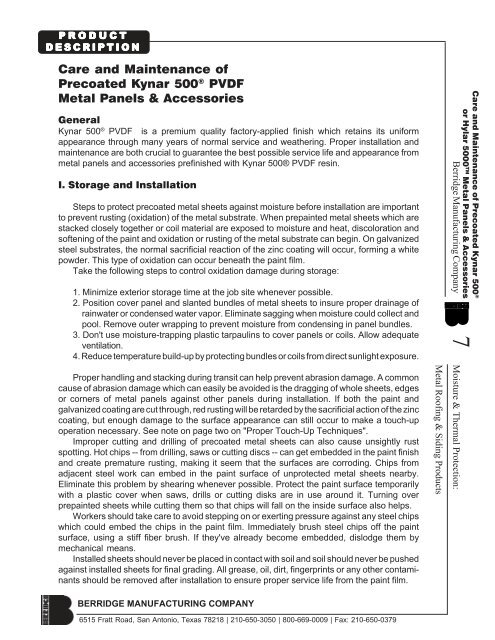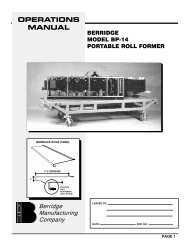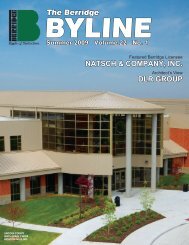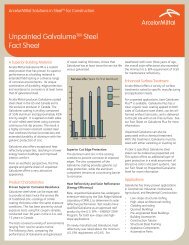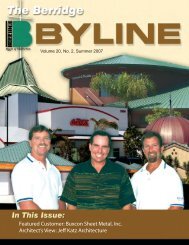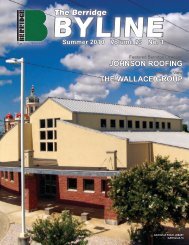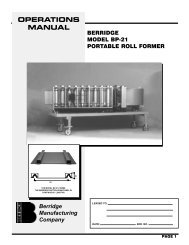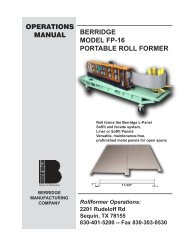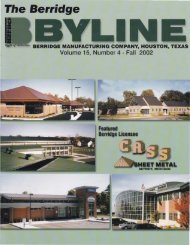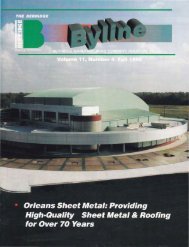Maintenance & Care of Painted Finishes - Berridge Manufacturing Co.
Maintenance & Care of Painted Finishes - Berridge Manufacturing Co.
Maintenance & Care of Painted Finishes - Berridge Manufacturing Co.
You also want an ePaper? Increase the reach of your titles
YUMPU automatically turns print PDFs into web optimized ePapers that Google loves.
PRODUCT<br />
DESCRIPTION<br />
<strong>Care</strong> and <strong>Maintenance</strong> <strong>of</strong><br />
Precoated Kynar 500 ® PVDF<br />
Metal Panels & Accessories<br />
General<br />
Kynar 500 ® PVDF is a premium quality factory-applied finish which retains its uniform<br />
appearance through many years <strong>of</strong> normal service and weathering. Proper installation and<br />
maintenance are both crucial to guarantee the best possible service life and appearance from<br />
metal panels and accessories prefinished with Kynar 500® PVDF resin.<br />
I. Storage and Installation<br />
Steps to protect precoated metal sheets against moisture before installation are important<br />
to prevent rusting (oxidation) <strong>of</strong> the metal substrate. When prepainted metal sheets which are<br />
stacked closely together or coil material are exposed to moisture and heat, discoloration and<br />
s<strong>of</strong>tening <strong>of</strong> the paint and oxidation or rusting <strong>of</strong> the metal substrate can begin. On galvanized<br />
steel substrates, the normal sacrificial reaction <strong>of</strong> the zinc coating will occur, forming a white<br />
powder. This type <strong>of</strong> oxidation can occur beneath the paint film.<br />
Take the following steps to control oxidation damage during storage:<br />
1. Minimize exterior storage time at the job site whenever possible.<br />
2. Position cover panel and slanted bundles <strong>of</strong> metal sheets to insure proper drainage <strong>of</strong><br />
rainwater or condensed water vapor. Eliminate sagging when moisture could collect and<br />
pool. Remove outer wrapping to prevent moisture from condensing in panel bundles.<br />
3. Don't use moisture-trapping plastic tarpaulins to cover panels or coils. Allow adequate<br />
ventilation.<br />
4. Reduce temperature build-up by protecting bundles or coils from direct sunlight exposure.<br />
Proper handling and stacking during transit can help prevent abrasion damage. A common<br />
cause <strong>of</strong> abrasion damage which can easily be avoided is the dragging <strong>of</strong> whole sheets, edges<br />
or corners <strong>of</strong> metal panels against other panels during installation. If both the paint and<br />
galvanized coating are cut through, red rusting will be retarded by the sacrificial action <strong>of</strong> the zinc<br />
coating, but enough damage to the surface appearance can still occur to make a touch-up<br />
operation necessary. See note on page two on "Proper Touch-Up Techniques".<br />
Improper cutting and drilling <strong>of</strong> precoated metal sheets can also cause unsightly rust<br />
spotting. Hot chips -- from drilling, saws or cutting discs -- can get embedded in the paint finish<br />
and create premature rusting, making it seem that the surfaces are corroding. Chips from<br />
adjacent steel work can embed in the paint surface <strong>of</strong> unprotected metal sheets nearby.<br />
Eliminate this problem by shearing whenever possible. Protect the paint surface temporarily<br />
with a plastic cover when saws, drills or cutting disks are in use around it. Turning over<br />
prepainted sheets while cutting them so that chips will fall on the inside surface also helps.<br />
Workers should take care to avoid stepping on or exerting pressure against any steel chips<br />
which could embed the chips in the paint film. Immediately brush steel chips <strong>of</strong>f the paint<br />
surface, using a stiff fiber brush. If they've already become embedded, dislodge them by<br />
mechanical means.<br />
Installed sheets should never be placed in contact with soil and soil should never be pushed<br />
against installed sheets for final grading. All grease, oil, dirt, fingerprints or any other contaminants<br />
should be removed after installation to ensure proper service life from the paint film.<br />
Metal Ro<strong>of</strong>ing & Siding Products<br />
<strong>Berridge</strong> <strong>Manufacturing</strong> <strong>Co</strong>mpany 7 Moisture & Thermal Protection:<br />
<strong>Care</strong> and <strong>Maintenance</strong> <strong>of</strong> Precoated Kynar 500 ®<br />
or Hylar 5000 TM Metal Panels & Accessories<br />
BERRIDGE MANUFACTURING COMPANY<br />
6515 Fratt Road, San Antonio, Texas 78218 | 210-650-3050 | 800-669-0009 | Fax: 210-650-0379
PRODUCT<br />
DESCRIPTION<br />
II. Cleaning <strong>Co</strong>ated Surfaces<br />
Although Kynar 500 ® PVDF resin-based coating factory-applied finishes are extremely<br />
durable, a periodic cleaning to remove build-ups <strong>of</strong> resins and other residue is a good idea to<br />
extend coating life.<br />
Simple washing with plain water using hoses or pressure spray equipment is usually<br />
adequate. When surfaces are dulled by heavy deposits <strong>of</strong> dirt or other contaminants, a heavyduty<br />
dry powdered laundry detergent (such as Tide®) mixed 1/3 cup with water may be used.<br />
A long-handled s<strong>of</strong>t bristle brush will make cleaning easier. Following cleaning operation with<br />
a clear water rinse.<br />
In areas subject to high humidity levels, mildew can occur. Although Kynar 500 ® PVDF<br />
finishes are inherently mildew-resistant, dirt and spore deposits can permit mildew growth to<br />
occur. The following solution is recommended to remove mildew when necessary:<br />
1/3 cup dry powdered laundry detergent (such as Tide®)<br />
2/3 cup tri-sodium phosphate or TSP (such as Soilax®)<br />
1 qt sodium hypochlorite 5% solution (such as Clorox®)<br />
3 qts water<br />
Avoid strong solvent and abrasive-type cleaners. Remove caulk compounds, oil,<br />
grease, tars, wax and similar substances by wiping with a cloth soaked in mineral spirits. Wipe<br />
only contaminated areas; follow with detergent cleaning and rinse thoroughly.<br />
III. Refinishing Factory-<strong>Co</strong>ated Panels & Accessories<br />
Properly refinished exterior building panels and accessories have a "like-new" appearance<br />
that protects the substrate from the environment. <strong>Care</strong>fully selecting the type <strong>of</strong> coating, along<br />
with proper surface preparation and application, are all essential elements <strong>of</strong> long-term<br />
performance satisfaction. Use pr<strong>of</strong>essional painting <strong>of</strong> the surface whenever possible.<br />
<strong>Berridge</strong> does not provide paint systems for field coating <strong>of</strong> metal ro<strong>of</strong>s. These paint systems<br />
are available through paint manufacturers such as Tristar, Sherwin Williams, Akzo Nobel and<br />
others. <strong>Co</strong>nsult these paint manufacturers directly regarding applicable paint systems,<br />
surface preparation and application instructions, as this varies by paint manufacturer.<br />
Note: for touch-up instructions please refer to <strong>Berridge</strong>'s Product Description titled: "Proper<br />
Touch-Up Techniques for Kynar 500 or Hylar 5000 Air-Dry Formula Paint."<br />
Metal Ro<strong>of</strong>ing & Siding Products<br />
<strong>Berridge</strong> <strong>Manufacturing</strong> <strong>Co</strong>mpany 7 Moisture & Thermal Protection:<br />
<strong>Care</strong> and <strong>Maintenance</strong> <strong>of</strong> Precoated Kynar 500 ®<br />
or Hylar 5000 TM Metal Panels & Accessories<br />
Note: Kynar 500 ® is a registered trademark <strong>of</strong> Arkema, Inc.<br />
Hylar 5000 ® is a registered trademark <strong>of</strong> Solvay Solexis.<br />
BERRIDGE MANUFACTURING COMPANY<br />
6515 Fratt Road, San Antonio, Texas 78218 | 210-650-3050 | 800-669-0009 | Fax: 210-650-0379
TECHNICAL BULLETIN 1050<br />
Metal Ro<strong>of</strong> <strong>Co</strong>ating<br />
<strong>Maintenance</strong><br />
CLEANING PAINTED SURFACES<br />
Polyester and Modified<br />
Polyester <strong>Co</strong>atings<br />
While factory applied finishes for<br />
metal building panels are so durable<br />
that they will last many years longer<br />
than ordinary paints, it is desirable<br />
to clean them thoroughly on a<br />
routine basis. Apparent discoloration<br />
<strong>of</strong> the paint may occur when it has<br />
been exposed in dirt-laden atmospheres<br />
for long periods <strong>of</strong> time.<br />
Slight chalking may also cause<br />
some change in appearance in areas<br />
<strong>of</strong> strong sunlight. A thorough<br />
cleaning will generally restore the<br />
appearance <strong>of</strong> these buildings and<br />
reader repainting unnecessary. An<br />
occasional light cleaning will also<br />
help maintain an aesthetically<br />
pleasing appearance. For any<br />
cleaning method used, it is recommended<br />
that the process be tested<br />
on a small inconspicuous area<br />
before use on a large scale.<br />
To maintain the original finish <strong>of</strong> the<br />
building panels, the only regular<br />
maintenance necessary is that <strong>of</strong> an<br />
annual washing. Mild solutions <strong>of</strong><br />
detergents or household ammonia<br />
will aid in the removal <strong>of</strong> most dirt,<br />
and the following are recommended<br />
levels:<br />
l. One cup <strong>of</strong> common detergent<br />
“which contains less than 0.5%<br />
phosphate (example - “Tide”),<br />
dissolved into 5 gallons <strong>of</strong> water.<br />
NOTE: The use <strong>of</strong> detergents<br />
containing greater than 0.5%<br />
phosphate are not recommended<br />
for use in general cleaning <strong>of</strong><br />
building panels. Never mix cleaners,<br />
since this could be ineffective<br />
as well as dangerous. For example,<br />
detergents containing<br />
ammonia or ammonia compounds<br />
mixed with bleach (which contains<br />
chlorine) can result in harmful<br />
vapors being formed.<br />
2. One cup <strong>of</strong> household ammonia<br />
dissolved into 5 gallons <strong>of</strong> water<br />
(room temperature).<br />
Working from the top to the<br />
bottom <strong>of</strong> the panels, the building<br />
may be washed with either<br />
solution using a well-soaked cloth,<br />
sponge, brush (with very s<strong>of</strong>t<br />
bristles) or low pressure spray<br />
washer. The use <strong>of</strong> scouring<br />
powder or industrial solvents are<br />
not recommended since these<br />
agents may damage the film, or<br />
leave unsightly sources for dirt<br />
accumulation.<br />
Solvent containing cleaners (examples<br />
“Fantastic” or “Formula 409”)<br />
are very effective and can be used<br />
without concern. If mildew or other<br />
fungal growth is a problem and<br />
cannot be removed as outlined<br />
above, household bleach - mixed at<br />
a concentration <strong>of</strong> one gallon bleach<br />
in five gallons <strong>of</strong> water, along with<br />
one cup <strong>of</strong> mild soap to aid wetting -<br />
is recommended.<br />
Once the building is washed,<br />
thorough rinsing with clear water is<br />
necessary to eliminate the possibility<br />
<strong>of</strong> residue. Failure to remove all<br />
residue from these cleaning steps<br />
may damage the film.<br />
Polyvinylidene Fluoride<br />
(PVDF) and Plastisol <strong>Co</strong>atings<br />
Polyvinylidene Fluoride (PVDF) and<br />
plastisol present relatively nonadherent<br />
surfaces to airborne soil. If<br />
needed, a variety <strong>of</strong> methods for<br />
removal <strong>of</strong> surface deposits is<br />
available. Two precautions are given:<br />
1. Do not use wire brushes, abrasives,<br />
or similar cleaning tools<br />
which will mechanically abrade the<br />
coating surface, and 2) in general,<br />
the cleaning agents listed below<br />
should be tested on a small,<br />
inconspicuous area before use on<br />
a large scale.<br />
HOT OR COLD<br />
DETERGENT SOLUTIONS<br />
A 5% solution in water <strong>of</strong> commonly<br />
used commercial and industrial<br />
detergents will not have any effect on<br />
the metal panel surface. Washing<br />
with these solutions should be<br />
followed by a thorough rinse <strong>of</strong> water.<br />
A cloth or s<strong>of</strong>t bristle brush should<br />
be used.<br />
SOLVENTS<br />
Most organic solvents are flammable<br />
and/or toxic and must be handled<br />
following manufacturer’s recommendations.<br />
They should be kept away<br />
from open flames, sparks, electrical<br />
motors and used with adequate<br />
ventilation and protective equipment<br />
Solvents that may be used to<br />
remove non-water soluble deposits<br />
(examples- tar, grease, oil paint,<br />
graffiti, sealants...) from PVDF and<br />
plastisol surfaces include:<br />
1. Alcohols -<br />
• Denatured alcohol (ethanol)<br />
• Isopropyl (rubbing alcohol)<br />
• Methanol (wood alcohol)<br />
2. Petroleum Products and<br />
Turpentine -<br />
• VM&P naphta (benzine)<br />
• Mineral spirits (oleum)<br />
• Kerosene<br />
• Turpentine (wood or gum<br />
spirits)<br />
3. Aromatic and Chlorinated
• Xylol (Xylene)<br />
• Toluol (Toluene)<br />
• Perchlorethylene (Perclene)<br />
• Trichlorethylene (Triclene)<br />
These solvents should be used with<br />
caution on PVDF and plastisol<br />
surfaces. A small area should be<br />
tested before general application;<br />
contact should be limited to five<br />
minutes.<br />
4. Ketones, Esters, Lacquer<br />
thinner, Paint Remover -<br />
• Methyl ethyl ketone (MEK)<br />
• Methyl isobutyl ketone (MIBK)<br />
• Ethyl acetate (nail polish<br />
remover)<br />
• Butyl acetate<br />
• Lacquer thinner<br />
• Paint remover (non-flammable)<br />
These solvents should be used with<br />
caution on PVDF and plastisol<br />
surfaces. A small area should be<br />
tested before general application;<br />
contact should be limited to one<br />
minute. Paint removers should be<br />
carefully tested on small areas<br />
following the manufacturer’s application<br />
recommendations.<br />
5. Acetone should not be used on<br />
PVDF and plastisol surfaces.<br />
CHEMICAL SOLUTIONS<br />
• Sodium hypochlorite solution<br />
(Laundry bleach, Clorox)<br />
• Hydrochloric acid (muriatic<br />
acid)<br />
• Oxalic acid<br />
• Acetic acid (vinegar)<br />
Acid solutions are corrosive and<br />
toxic. They should be tested on<br />
small areas before general applica-<br />
tion; contact should be limited to five<br />
minutes. The panel surface should<br />
be thoroughly flushed with water<br />
after the chemical solution washing.<br />
GRAFFITI<br />
Graffiti presents a special problem<br />
because <strong>of</strong> the many possible<br />
agents used, generally aerosol paint<br />
It is recommended that less active<br />
solvents (examples - alcohols,<br />
petroleum solvents and turpentine,<br />
aromatic and chlorinated) be tried<br />
initially, followed by stronger solvents<br />
(examples -ketones, esters, lacquer<br />
thinner, paint remover). If none <strong>of</strong><br />
these are satisfactory, it may be<br />
necessary to resort to touch-up<br />
paint, total repainting or replacement.<br />
This technical bulletin has been<br />
distributed, prior to publication,<br />
for review and comment by those<br />
organizations believed to have a<br />
direct interest in and knowledge<br />
<strong>of</strong> the subject matter.<br />
11 S. LaSalle St. Suite 1400 Chicago, IL 60603<br />
(312) 201-0193 • Fax (312) 201-0214<br />
or P.O. Box 697 Chicago, IL 60690-0697<br />
ISSUED 7/97 TB 1050<br />
NOTE: This bulletin has been reproduced from the original<br />
MCA Technical Bulletin


